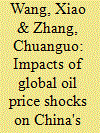|
|
|
Sort Order |
|
|
|
Items / Page
|
|
|
|
|
|
|
| Srl | Item |
| 1 |
ID:
137670


|
|
|
|
|
| Summary/Abstract |
China implemented a package of policies during the 11th Five-Year Plan (2006–2010) to improve industrial energy efficiency. This assessment provides a methodology that establishes a causal relationship between policy implementation and energy conservation effects. To enhance the confidence in the research findings, this assessment applies two distinctive and independent approaches: one top-down and the other bottom-up. This assessment finds that industrial energy efficiency policies collectively achieved energy savings of 322 Mtce (9.4 EJ) against the baseline scenario. This accounted for 59% of the sector's total energy savings from 2006 to 2010. The remaining energy savings were realised through autonomous technology improvement (33%) and sector-level structural shift (8%). Correspondingly, cumulative avoided CO2 emissions realised through energy efficiency policies amounted to 760 million tons. This assessment concludes that industrial energy efficiency policies were effective in realising energy conservation targets, but energy conservation effects were not achieved in a cost-effective way. Command and control measures were dominantly implemented, with economic incentives and informational measures taking a complementary role; while market based instruments did not play an important role. As China is planning on implementing a nationwide emissions trading scheme, special attention needs to be paid to policy interaction and coordination.
|
|
|
|
|
|
|
|
|
|
|
|
|
|
|
|
| 2 |
ID:
171428


|
|
|
|
|
| Summary/Abstract |
The consumption of fossil fuels has resulted in the increasing environmental pressure and a series of environmental pollution problems. Taking four Chinese cities (Beijing, Tianjin, Shanghai and Chongqing) as examples, the reasons of fog and haze caused by multi-factor coupling were studied in this paper. Firstly, the contribution of four factors (including building completed area, thermal power generation, gross industrial output value and wind speed) to fog and haze in Tianjin was analyzed, and then these four cities were compared to explore the impact of the same factor on fog and haze in different regions. Secondly, the functional relationships between these four factors and air quality index (AQI) were obtained based on statistical data, and a sensitivity analysis was carried out to get the dominant factor of fog and haze in these four cities. Finally, the corresponding policy recommendations were given based on different dominant factors of these four cities.
|
|
|
|
|
|
|
|
|
|
|
|
|
|
|
|
| 3 |
ID:
133210


|
|
|
|
|
| Publication |
2014.
|
| Summary/Abstract |
This paper investigated the impacts of oil price shocks on China×s fundamental industries. In order to analyze the reactions of different industries to oil price shocks, we focused on four fundamental industries: grains, metals, petrochemicals and oil fats. We separated the oil price shocks into two parts, positive and negative parts, to investigate how commodity markets react when oil prices go up and down. We further studied the extreme price movements, called jumps, existing in the oil markets and how jump behavior has affected China×s commodity markets. Our results suggest that asymmetric effects of oil price shocks did exist in the four markets and the negative oil price shocks had stronger influences on the four markets in China. The petrochemicals market suffered most from the oil price shocks, and the grains market was least sensitive to the shocks. When jumps occurred in the crude oil market, the four commodity markets would be affected differently. The oil fats market and petrochemicals market tended to "overreact" to jumps.
|
|
|
|
|
|
|
|
|
|
|
|
|
|
|
|
|
|
|
|
|